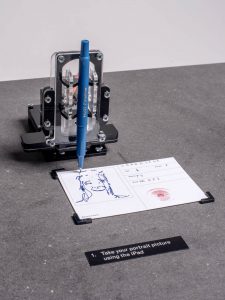Martin Hertig’s Sensible Data is an art installation made out of 3 interactive devices. It invites participants to make a physical passport through 3 distinct steps. The devices are modified variants of Piccolo CNC (an open source machine which uses arduino) and a Raspberry Pi coordinates all 3 machines to create a seamless process.
First, the participant takes a selfie portrait using the iPad. The first device will start making a line drawing passport photo of the participant.
Next, the participant is tasked to send an email to the a given address. This analyses and judges the selfie portrait they previously took using an algorithm. It returns data and triggers the second device to stamp in specific details on their passport such as beauty percentage, age, gender and mood. This information is stored in a database. The machines are very well made; not as efficient as a printer but the mechanical action is visible and adds visual interest.
Lastly, the participant presses a nondescript button which is actually a fingerprint scanner. This validates their passport, and the third device stamps a seal onto it. The physical passport is thus completed. An email with all the data of a matching person in the database is sent to the user. This begs a question so relevant in our modern age of information and technology: how much do we value confidentiality and the privacy of our personal data?
While the circumstances and conditions are intentionally absurd (it sends participants the data of another user whose portrait drawing has the same number of lines), Sensible Data brings up important issues that we have to consider, such as the tradeoffs of technology and immediacy, placing trusts in systems, measuring human qualities using computerised systems and assigning numbers to these qualities etc.
The devices come together pretty well and have a key role in the installation. Each device has a simple core concept and task it performs. I feel that asking the viewer to go through multiple steps and perform different actions is often less effective as the drawn-out experience requires sustained attention from the participant. It often makes for a choppy and cumbersome art experience. However, Hertig’s work doesn’t strike me as tedious or overly-complicated. It is successful perhaps because the end goal is clearly made known to the user from the start: simply make a passport. Each step also provides instant gratification and each action has an immediate, visible outcome. This sustains user attention and increases the continuity of the work.
Sensible Data in action:
More details regarding the technical process can be found here:
Martin Hertig:
http://martinhertig.ch/





